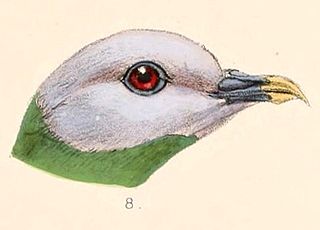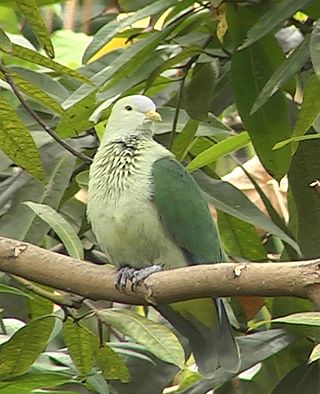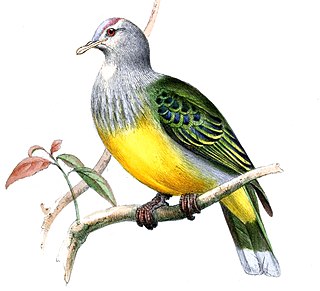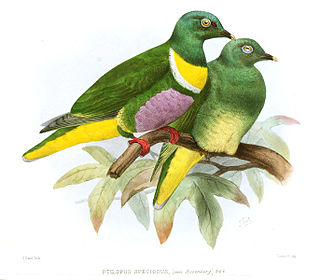
Wallace's fruit dove is a species of a bird in the pigeon family Columbidae. The name commemorates the British naturalist Alfred Russel Wallace. It is a rather large, long-tailed fruit dove with a length of 24–28 cm (9.4–11.0 in) and has been described as "one of the most beautiful" fruit doves. The forehead and crown are dull crimson, the lower face and throat are white, and the rest of the head, breast, neck, and upper back are pale bluish-grey. The wings and lower back are green and the belly is orange, separated from the chest by a white band. Both sexes look similar, but females have less extensive red on the head and a greenish tinge to their grey parts.

The black wood pigeon or Japanese wood pigeon is a species of bird in the family Columbidae. It is found in East Asia along shorelines of the Pacific's Korea Strait, Philippine Sea and East China Sea. It is believed to be the largest representative of the genus, Columba, and has a weight of around 550 grams (1.2 lb) and an overall length of 43 cm (17 in). Its natural habitats are temperate forests and subtropical or tropical moist lowland forests. The species is in decline owing to habitat loss, habitat degradation, deforestation and hunting. This wood pigeon is endemic to the laurel forest habitat.
The grey-headed imperial pigeon is a species of bird in the family Columbidae. It is endemic to Sulawesi in Indonesia. Its natural habitats are subtropical or tropical moist lowland forests and subtropical or tropical moist montane forests.

The Makatea fruit dove is a species of bird in the family Columbidae. It is endemic to French Polynesia island of Makatea in the Tuamotu Archipelago. Its natural habitat is subtropical or tropical moist lowland forests and is also present near villages. This bird is approximately 20 cm tall and has plumage of mostly green feathers with a dark purple crown and forehead, pale greenish-grey throat and chest, cloven lower chest feathers producing rows of shadows that appear as streaks, yellow underparts, tinged orange anteriorly. The bird's wing feathers are edged yellow. While it continues to be threatened by habitat loss, a decrease in mining since the mid 1960s has helped re-vegetation and appears to have stabilized population numbers.

The atoll fruit dove is a species of bird in the family Columbidae. It is endemic to the Tuamotu archipelago in French Polynesia. Its natural habitats are subtropical or tropical moist lowland forests and plantations. It is threatened by habitat loss.

The red-naped fruit dove is a species of bird in the family Columbidae. It is endemic to Sumba.

The white-headed fruit dove is a species of bird in the pigeon family Columbidae. It was described by the English ornithologist John Gould in 1856, and the specific name eugeniae honours the French empress Eugénie de Montijo. Adults of the species have white heads, a purplish-red breast patch, a grey shoulder patch, olive-green upperparts, greenish underparts with a blue tinge, and a yellowish vent. Juveniles have green heads with the white restricted to the forehead and upper throat, a much smaller grey shoulder patch, and the red breast patch restricted to the centre of the breast.

The grey-headed fruit dove or gray-headed fruit dove is a species of bird in the family Columbidae. It is endemic to the northern Moluccas.

The flame-breasted fruit dove is a species of bird in the family Columbidae. It is endemic to the Philippines only being found in the mountains of Luzon.This is a large dove reaching 42 cm long, being the largest fruit dove in the country and rivalling the size of Imperial pigeons. It is identified with its red hood, black wings with a red patch on its secondaries and its unmistakable flame-coloured breast. Its natural habitats are in upper areas of the tropical moist lowland forest and in mid to upper montane forest. It is threatened by habitat loss, poaching for the pet trade and hunting for food.

The many-colored fruit dove, also known as manuma in the Samoan language, is a species of bird in the family Columbidae. It occurs on islands in the south-west Pacific Ocean where it is found in Fiji, the Samoan Islands, and Tonga. Its natural habitat is subtropical or tropical moist lowland forests. Today, the birds are most often found in Fiji and Tonga. It usually feeds high in the canopy on fruit and berries, especially banyan fig. The nest is a small platform of twigs where one white egg is laid.

The crimson-crowned fruit dove, also the Tongan fruit dove or purple-capped fruit dove, is a species of bird in the family Columbidae. It is found in American Samoa, Fiji, Marshall Islands, Niue, Samoa, Tonga, and Wallis and Futuna Islands. Its natural habitats are subtropical or tropical moist lowland forest and subtropical or tropical mangrove forest.

The grey-green fruit dove is a species of bird in the family Columbidae. It is endemic to the Society Islands in French Polynesia. Its natural habitat is subtropical or tropical moist lowland forests.

The white-bibbed fruit dove is a species of bird in the family Columbidae.
Oberholser's fruit dove is a species of bird in the family Columbidae. It was formerly named P. epius, but it has since been revised to the earlier name P. gularis. It is endemic to Sulawesi. Its natural habitat is subtropical or tropical moist lowland forests. It is threatened by habitat loss.
The Tanna fruit dove is a species of bird in the family Columbidae. It is endemic to Vanuatu.
The Sula fruit dove is a species of bird in the family Columbidae. It is endemic to the Sula Islands. Its natural habitat is subtropical or tropical moist lowland forests. It is threatened by habitat loss.

The purple-capped fruit dove or Pohnpei fruit dove, is a species of bird in the family Columbidae found on Chuuk and Pohnpei in the Caroline Islands. It was formerly considered as a subspecies of the crimson-crowned fruit dove. Its natural habitats are subtropical or tropical moist lowland forests and subtropical or tropical mangrove forests.

The fruit doves, also known as fruit pigeons, are a genus (Ptilinopus) of birds in the pigeon and dove family (Columbidae). These colourful, frugivorous doves are found in forests and woodlands in Southeast Asia and Oceania. It is a large genus with over 50 species, some threatened or already extinct.

The Raiatea fruit dove is a species of bird in the family Columbidae. It is endemic to the Society Islands in French Polynesia. Although first named to science in 1853, this fruit dove was evidently discovered 30 years earlier, by René Primevère Lesson (1794–1849), while serving as naturalist aboard La Coquille. It was formerly considered a subspecies of the grey-green fruit dove but was split as a distinct species by the IOC in 2021. Its natural habitat is subtropical or tropical moist lowland forests.

The Geelvink fruit dove is a species of bird in the family Columbidae. It is native to several islands, including Biak, Supiori, Numfor, and the smaller Padaido Islands, collectively known as the Schouten or Geelvink Islands, which lie north of New Guinea.
















